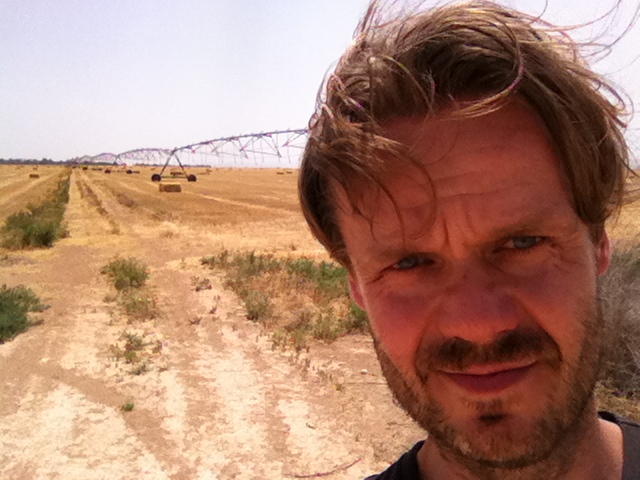MODELLING THE FOOTPRINT OF THE LAND ON THE ATMOSPHERE
The subject of this dissertation is how to make effective use of remote-sensing based techniques in determining fluxes of water vapour and heat under conditions of surface and atmospheric heterogeneity. This concerned setting up of a model that (tries to) ignore, or minimize the influence of atmospheric heterogeneity on flux estimates, incorporating surface heterogeneity in ground-based observations that are used for flux validation and developing a method to incorporate and quantify the influence of atmospheric heterogeneity on flux estimates.

Minimization of atmospheric - influence A remote sensing-based framework was developed for the automated estimation of surface energy balance components from remotely sensed radiometric surface temperature only. The method, called DATTUTDUT, can be used to derive a spatially distributed map of actual evapotranspiration over large heterogeneous areas, provided that hydrologic extremes or both wet and dry conditions are present. This simple and fully automated scheme, which is of the physically-based index type, was shown to provide estimates of the available energy (net radiation less soil heat flux) and turbulent sensible and latent heat fluxes comparable to established and more complex remote sensing-based schemes. Only under dry and sparsely vegetated conditions discrepancies with observations were significant, a phenomenon not uncommon for these type of approaches. Given the simplicity of the algorithm and its ease of use, the proposed model has utility in identifying areas of high and low water use and therefore can serve as an operational tool for rapid monitoring of relative water use or plant stress conditions in regions having little ground information.
Incorporation of surface influence - A methodology was proposed to produce scintillometer-derived area-averages of sensible heat fluxes suitable for validating spatially distributed models that estimate surface fluxes by remote sensing observations. The soundness of the method is demonstrated by reproducing reference fluxes from land cover component fluxes. When applied over a very heterogeneous surface, some complications are noticed when both stable and unstable conditions occurred within the footprint of the scintillometer. However, when the contrast between land cover components is not too large, deviations between scintillometer-based estimates and reference values were within 20 Wm-2.
Incorporation of atmospheric influence - A Large-Eddy Simulation (LES) model was linked with remotely sensed land surface states using a patch version of a dual source energy balance model to assess land-atmosphere coupling over the very heterogeneous agricultural landscape near Barrax, Spain. The coupled model was applied in a decoupled way, with static uniform atmospheric states and with spatially variable atmospheric states in a dynamically coupled way. A significant difference in the spatial averages and a decrease in spatial variance of the fluxes was found when comparing results from the coupled with the decoupled simulations. From a multi-scale analysis on the relation between surface and air temperature it was found that the spatial variability of the air temperature was induced preferentially from variations in surface temperature occurring at scales of 500 to 1000 meter. Though the spatial variation in air temperature was found to be fairly small as compared to those of the surface temperature, these results were in line with previous work over a natural semi-arid rangeland area.These findings led to the development of a new tool that enables to examine each parameter of importance in terms of coupling, in addition to the turbulent fluxes. The tool contains recently developed Sub-Grid-Scale (SGS) model parameterizations and new discretizations in the LES part, and is dynamically coupled to the series version of the TSEB model. Model performance over homogeneous synthetic surfaces now showed near-surface results that better followed Monin-Obukhov Similarity Theory (MOST) and better represented typical profiles of parameters such as turbulent viscosity, Schmidt and Prandtl number. Model results over heterogeneous, synthetic as well as natural, surfaces showed that the wind speed is the dominant factor for deviations between coupled and decoupled flux estimates. This holds true for heterogeneity in LST, z0M, FVC as well as for z0H, which are typical spatially variable input parameters in remote sensing-based LSMs. For individual land cover units, clear and mostly linear relations were found between differences in wind speed and differences in H between coupled and decoupled runs, potentially providing a means to incorporate atmospheric variability in decoupled models. However, no general approach could be established to map spatial variation in wind speed due to the complex interplay between buoyancy-driven and mechanically-driven variation in wind speed. Evaluation of the new tool versus observations from the REFLEX2012 campaign, specifically designed for studying land-atmosphere interactions over the heterogeneous Barrax area, showed an increased spatial variability in wind speed and scalar concentration, slightly better H estimates and slightly poorer lE estimates. However, inclusion of the feedback effects for the current LSM parameterization over the current area yielded deviations in flux estimates that are largely within turbulent flux observation accuracy.





